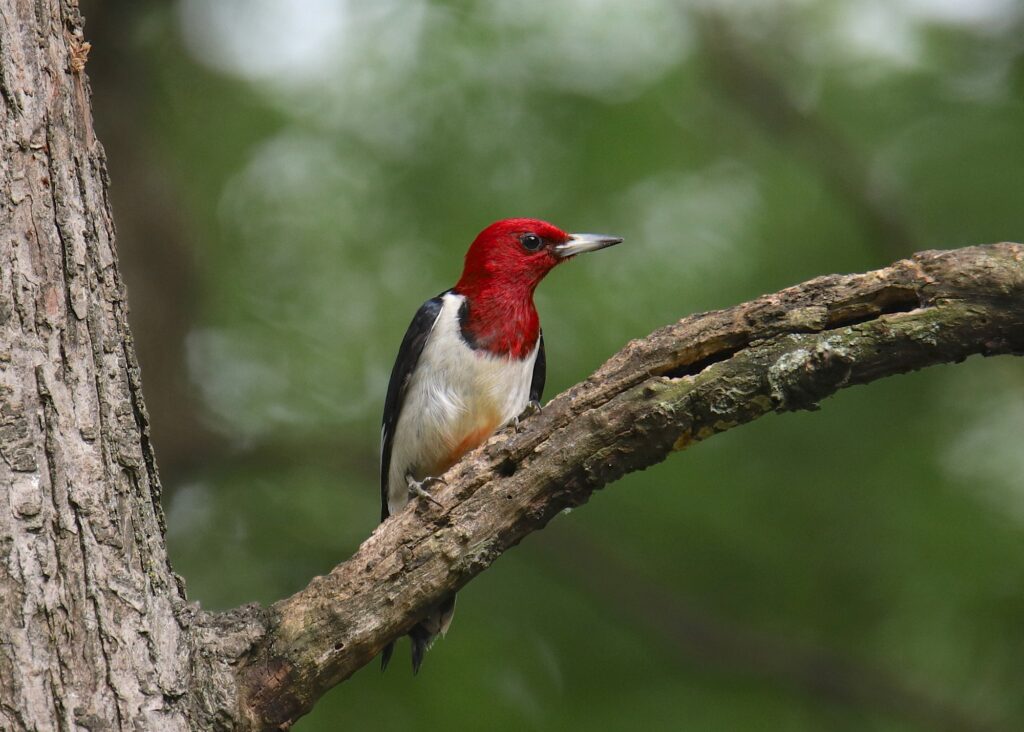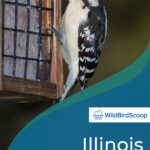Out of the 800 bird species in North America, there are 400 in Illinois alone! Seven of them are woodpecker species that you may come across on your next trip to the state.
With Lake Michigan on its north and the Mississippi River on its borders, it’s no wonder the 58,000 square mile state has become host to vast farmland.
As a result, the state is now home to a wide range of habitats. The dead trees provide enough cavities for nesting and pecking, which is all that woodpeckers need. The colorful birds also spread further to reach Chicago. A couple of species are found there almost all year long.
In this article, we’ll explore the woodpeckers in Illinois and everything you need to know about them.
Downy Woodpecker
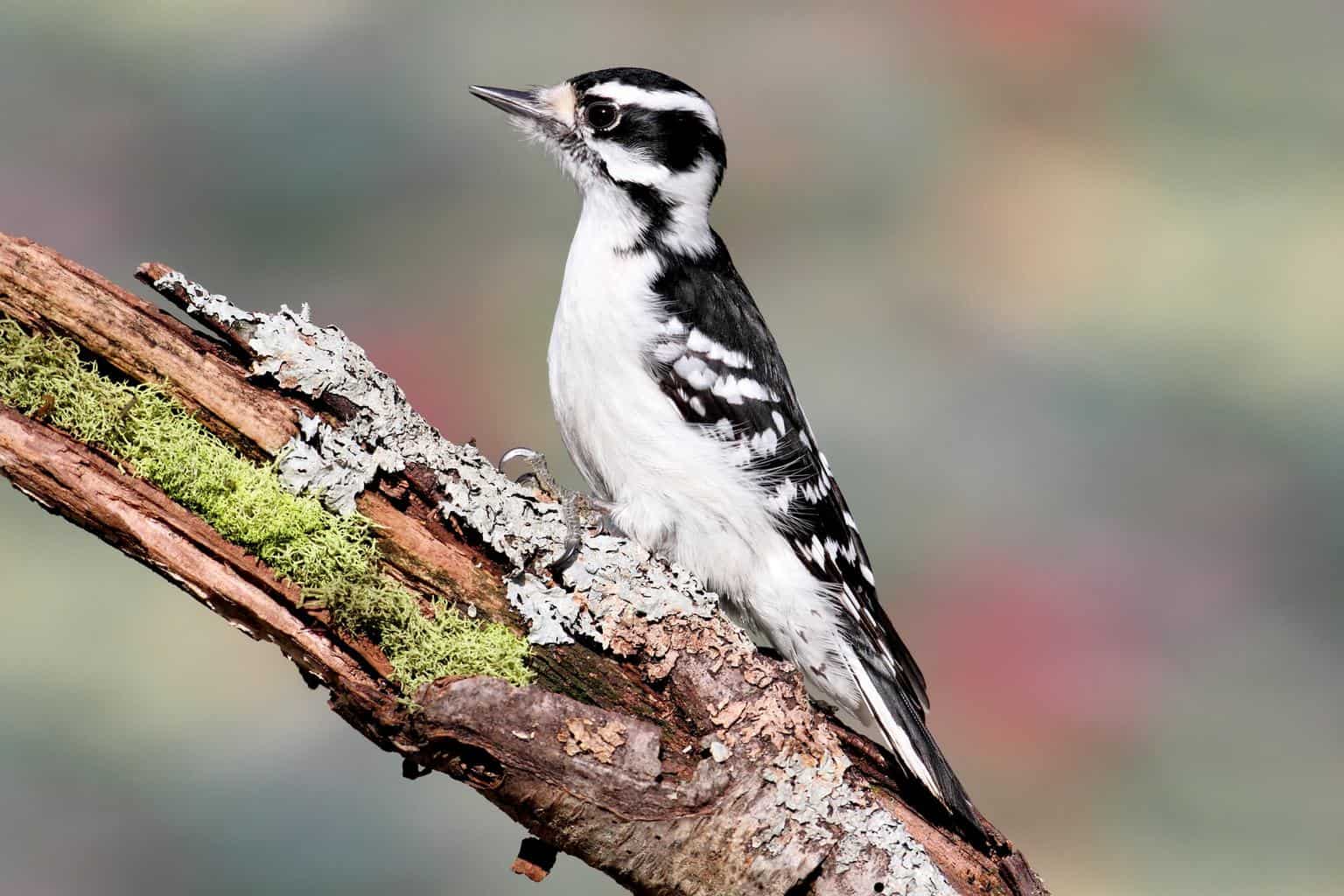
- Scientific Name: Dryobates pubescens
- Length: 5.5–7 inches
- Weight: 0.7–1 ounce
- Wingspan: 10–11.8 inches
Downy Woodpeckers are slightly smaller than their close cousins: hairy woodpeckers. Their bodies are 5–6 inches tall, and their males are easily recognizable by the red spot on their heads.
Behavior
Downy woodpeckers mostly build their nests in dead trees. They choose these trees because their wood will likely be infected by fungus, which makes it easier to peck through.
The little birds fly in horizontal and downward motions, but they do it more steadily than most woodpeckers. They mostly stay perched on top of trees, and they occasionally hop down for food.
Where to Find Them
Downy woodpeckers don’t get far away from residential areas and open woodlands. You’ll likely find them near dead treas. Out of the woods, you’ll find them in vacant areas and parks.
How to Attract Them
Downy woodpeckers are among the species that get attracted to bird feeders, which is good news for you. You can place the feeder in your backyard and wait for the bird to make its appearance.
The birds feed on seeds, peanuts, suet, and insects. You have a variety of foods to offer them.
Hairy Woodpecker
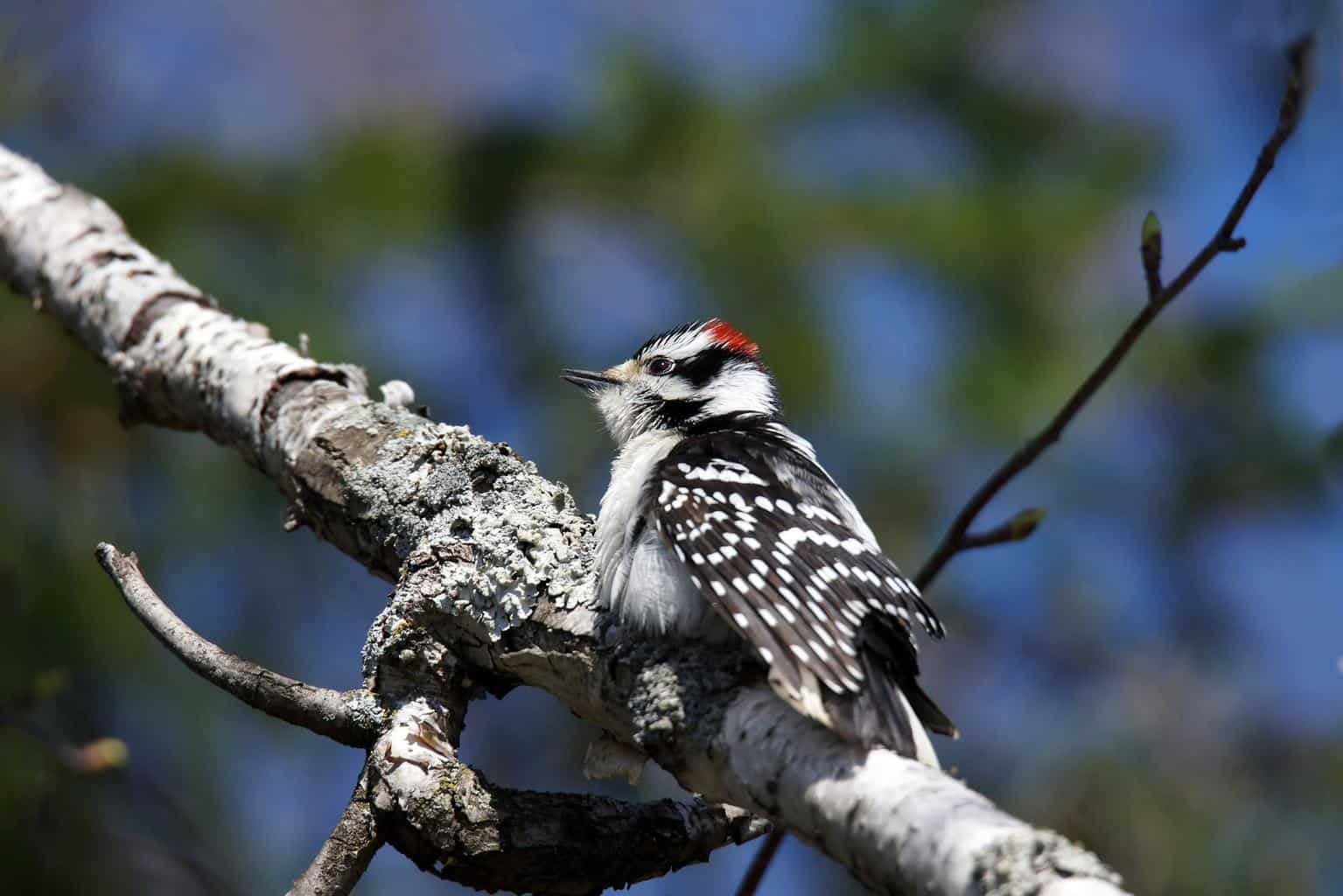
- Scientific Name: Dryobates villosus
- Length: 7–10.2 inches
- Weight: 1.4–3.4 ounces
- Wingspan: 13–16.1 inches
Hairy woodpeckers have white backs and outer tail feathers. They’re larger than downy woodpeckers, but they’re less common.
Behavior
Hairy woodpeckers mostly spend their time at the bases of trees, unlike their downy cousins. While flying, they stretch their necks out and move their heads constantly from side to side.
The birds are known for their shrill cries. They move their wings at a 45-degree angle to the back, crane their heads, and let it all out!
Where to Find Them
Same as downy woodpeckers, you can find hairy woodpeckers in residential areas and forests. You’ll find them around beaver ponds, on oak trees, and in southern swamps. They may also visit your backyard every once in a while.
How to Attract Them
If you want to bring hairy woodpeckers to your yard, you can lay out some peanuts or black oil sunflower seeds for them. They’re more likely to visit in winter since that’s when they need food the most.
Northern Flicker

- Scientific Name: Colaptes auratus
- Length: 11–12.2 inches
- Weight: 3.9–5.6 ounces
- Wingspan: 16.5–20.1 inches
Northern Flickers are the most common woodpecker species in the US. You can find them in almost all states. Their backs and bellies are full of spots, and their heads are colorful.
Behavior
As opposed to all woodpeckers, northern flickers mostly stay on the ground. That’s why most people mistake them for other species. You’ll rarely find a northern flicker perched on top of a tree.
When flying, they rise and fall smoothly, switching between gliding and flapping every few seconds.
Where to Find Them
Northern flickers are easy to find, seeing as they stay on the ground most of the time. You’ll find them in any open habitat, such as city parks and fields. They’ll be close to residential areas because that’s where they’ll find their food.
How to Attract Them
Northern flickers feed on insects, berries, and seeds. You can lay the food out in the feeder and wait for them. However, they likely won’t get attracted to feeders.
If you put a nest box, you may get lucky with a breeding pair of flickers. Other than that, you may only find them at birdbaths.
Pileated Woodpecker
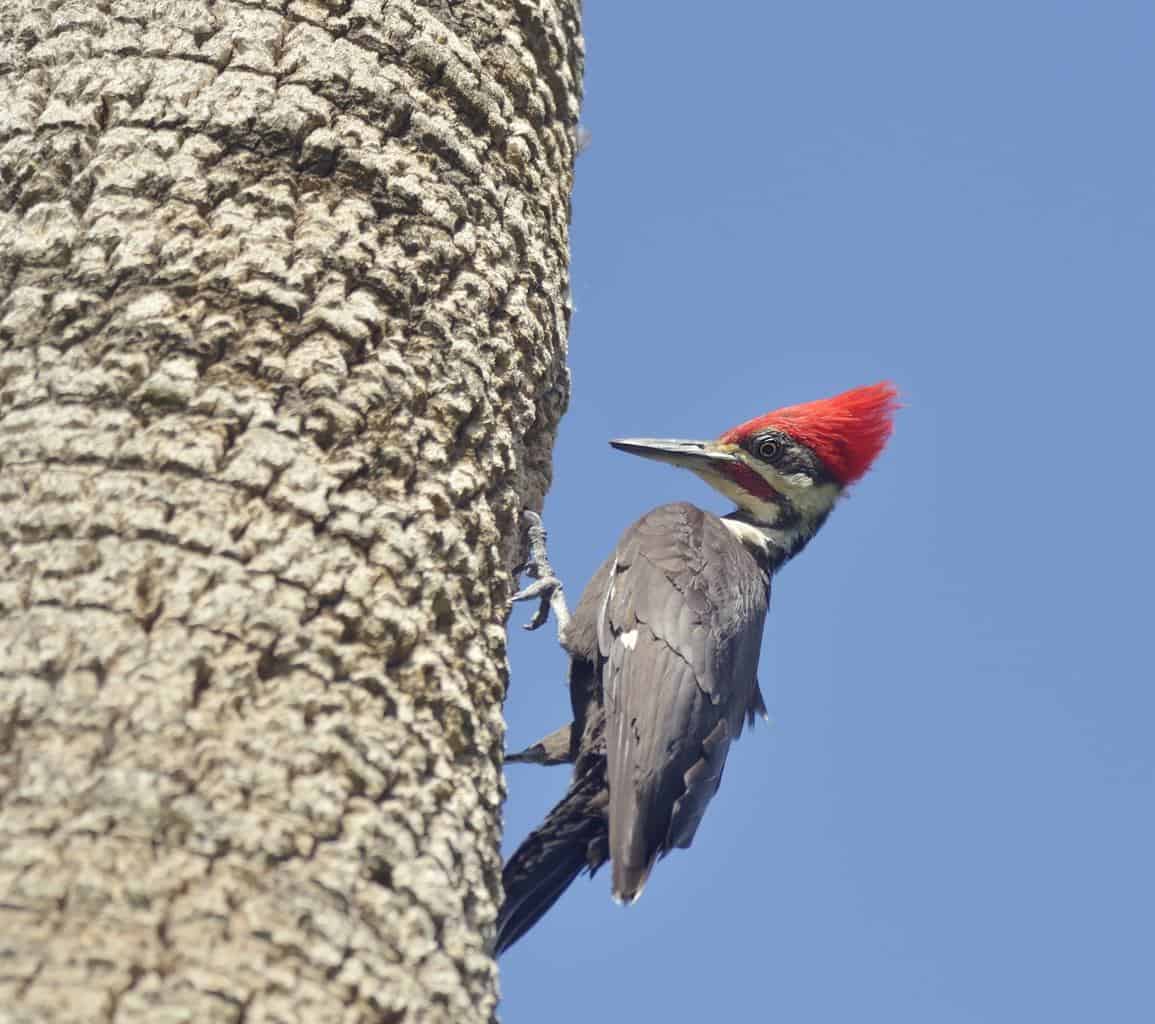
- Scientific Name: Dryocopus pileatus
- Length: 15.8–19.3 inches
- Weight: 8.8–12.3 ounces
- Wingspan: 26–29.5 inches
Pileated woodpeckers are the easiest species to recognize, although they don’t appear frequently. They have white stripes on their faces, and a striking red color tops off their heads.
Behavior
Pileated woodpeckers are known for the rectangular cavities they peck through trees. Each cavity can reach more than a foot long, which is impressive for the bird’s size. As they peck, they stretch their long necks away from the tree and powerfully strike using their peaks.
The red-headed birds have one mate at a time, and they stay in small numbers. You’ll rarely see a large number of them at once.
Where to Find Them
Pileated woodpeckers mostly forage around woodlands, where there are deciduous trees and trunks. You’ll find them in forests and suburban areas that have open woodlands.
You may also find them in any city park that has several dead trees.
How to Attract Them
Pileated woodpeckers are hard to attract to your backyard. They won’t visit unless there are one or two dead trees around. If you want to attract them in the breeding season, you can lay out some suet and provide a nest box.
Red-bellied Woodpeckers

- Scientific Name: Melanerpes carolinus
- Length: 9.4 inches
- Weight: 2–3.2 ounces
- Wingspan: 13–16.5 inches
Red-bellied woodpeckers have a tricky name. Their stomachs barely have a hint of red in them. Instead, their heads are topped off by the vivid red color. Their females have red napes too.
Behavior
Red-bellied peckers are often perched on top of tree branches, looking for insects to feed on. Sometimes, the males tap softly on the tree in an attempt to attract females. You’d be lucky if you encounter one of these dates!
The red birds don’t associate with other birds much. So, they probably won’t visit your backyard feeder if there are any other species there.
Where to Find Them
Numbers of red-bellied woodpeckers have been on the rise in Illinois in the last few years. That’s because it has everything they’re looking for: forests, wooded suburbs, and woodlands. You’ll find them in pine-hardwood and maple forests, in particular.
How to Attract Them
If you want to get red-bellied peckers to your feeder, you can provide food for them. They feed on suet, peanuts, or sunflower seeds. Additionally, they may drink nectar from hummingbird feeders.
If you have a dead tree in your backyard, it’ll serve as an attraction for the red woodpeckers.
Red-headed Woodpeckers
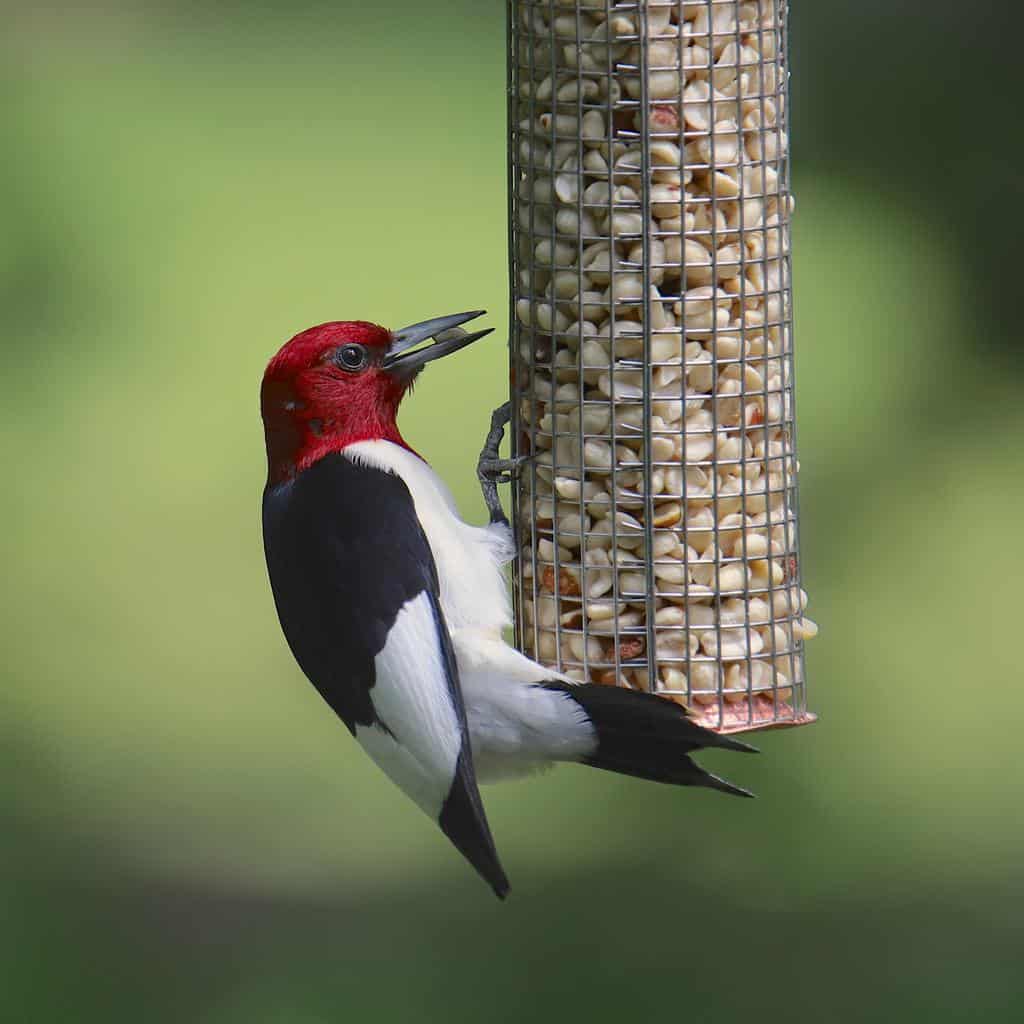
- Scientific Name: Melanerpes erythrocephalus
- Length: 7.5–9.1 inches
- Weight: 2–3.2 ounces
- Wingspan: 16.5 inches
Red-headed woodpeckers are true to their name. They have red heads and while stomachs. Their color pattern is unique, so you’ll easily identify them.
Behavior
The red-headed birds tend to stay still for a long time. Don’t get alarmed when you see one of them sitting in its place doing nothing for hours. They mostly stay on top of tree trunks, and they’re strong fliers.
Where to Find Them
You can find the red-headed peckers in oak and beech woodlands, along with river bottoms, farmlands, parks, and dead trees. When it’s breeding season, they move to the forest edges.
How to Attract Them
You may find red-headed woodpeckers at your bird feeder in winter. They’ll eat any seeds you leave there, as well as suet and any kind of fruit.
Yellow-bellied Sapsucker

- Scientific Name: Sphyrapicus varius
- Length: 7.1–8.7 inches
- Weight: 1.5–1.9 ounces
- Wingspan: 13.4–15.8 inches
Yellow-bellied sapsuckers are the most migratory species of Illinois. They take the Rocky Mountains as their home in the winter, and they breed in Illinois in the summer. The birds have a red patch on their foreheads, and their underside has a yellow color.
Behavior
The yellow sapsuckers’ behavior doesn’t stray far from the other woodpeckers. They hitch up and down trees, pecking at trunks to make a nest cavity. They also fly in a bouncing manner, which makes them easy to identify.
Where to Find Them
Unlike most woodpeckers, the sapsuckers aren’t fond of dead trees. Instead, you’ll find them on trunks of growing trees, pecking through sap wells. In the hot months, they move to the forest edges.
How to Attract Them
Yellow-bellied sapsuckers rarely come by bird feeders. They’re a bit challenging to attract, but you can try your luck. They may come across your yard if you have young maple trees around. Otherwise, you can use suet feeders.
Final Thoughts
Seven may seem like a small number, considering Illinois boasts more than 50,000 square miles. However, there’s a high chance you’ll run across any species of woodpeckers, even if you’re going on a short trip.
Remember to stay silent and watch them from afar. You’d be lucky if you run into one of them pecking into a tree. The sight of their heads popping and their peaks repeatedly striking the wood is beautiful, indeed!

